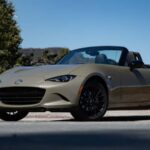The Camry lineup goes all-hybrid, with refinements across the board.
One does not typically look to a new Toyota Camry for revolution. Toyota perfected its mid-size sedan formula decades ago, and each successive generation has been an iterative improvement on the last. But this new, ninth-generation Camry brings with it a quiet revolution—it’s going hybrid only.
That’s a big deal for a car that, even in today’s age of SUV dominance, moves around 300,000 units per year in the US alone. Right now, hybrids make up about 20 percent of Camry sales, a little under 60,000 of the 290,000 sold here last year. That figure is about to go up by 230,000 cars or so.
| Quick Specs | 2025 Toyota Camry LE FWD |
| Engine | 2.5-Liter Four-Cylinder Hybrid |
| Output | 225 Horsepower (232 HP w/AWD) |
| Fuel Economy | 53 City / 50 Highway / 51 Combined |
| Price | $28,400 |
Toyota had us out to San Diego to drive the 2025 Camry alongside a handful of other new models. Our time with the new sedan was limited, but a couple hours on mountain roads near the border town of Tecate, and around town in San Diego, gave us a good first impression. Put simply, the new Camry is exactly what it needs to be.
Like the new Prius, the Camry gets a version of Toyota’s fifth-generation hybrid system (THS 5), though it swaps the 2.0-liter four-cylinder for a reworked version of the old car’s 2.5-liter. The ‘four, which runs a super high compression ratio of 14.0:1, makes 184 horsepower and 163 pound-feet of torque on its own. Combined with THS’s two motor-generator units, total system output rises to 225 hp. The all-wheel drive Camry adds an additional electric motor for the rear wheels, which brings total output to 232 hp.
Otherwise, the new Camry isn’t radically different from its predecessor. It uses the same platform, shod with new bodywork, and a reworked interior with Toyota’s freshest infotainment system. All of Toyota’s latest driver assists come standard—as it should be—plus a tweaked chassis and braking system. Outside of the powertrain, there’s no revolution, and that’s a good thing.
Mark DeJongh, chief engineer for the Camry said his team’s motto was “sedan to the core.” They know what a Camry is and should be, and they saw it as their job to improve what already worked so well. They nailed the brief.
The new Camry is extremely refined, no matter the trim. DeJongh says one of the ideas with the powertrain calibration was to give a more EV-like feel to the acceleration. That means immediate, yet smooth response to accelerator-pedal input. The Camry delivers, and what’s surprising is that it feels genuinely quick. I thought I’d miss the old Camry’s optional V-6, yet the hybrid powertrain provides more than enough oomph from town up to highway speeds.
There’s naturally some of the engine droning we’ve become accustomed to with a hybrid powertrain that eschews a traditional transmission, as the engine is held in the ideal rev range for acceleration. But in cruising, it’s barely audible. We didn’t do any scientific fuel-economy testing, but Toyota quotes 51 miles per gallon combined for the base LE and 44 miles per gallon for the all-wheel drive XSE. On a run from the mountains near the border, and to San Diego proper, we easily beat that figure in an XSE AWD, and without really trying. We’re talking air-conditioning full blast, keeping up with traffic, etc.
Toyota made the biggest chassis tweaks to the “sport” models, SE and XSE. I use quotations because the new Camry isn’t a sports sedan. DeJongh makes that very clear. Still, out on the mountain roads, the handling is quite good, inspiring confidence. Do many Camry buyers care about this sort of thing? Doubtful, but it’s nice to see that Toyota engineers do.
Good handling doesn’t come at the expense of ride quality, even on 19-inch wheels, though the ride in the XLE is noticeably plusher. DeJongh is particularly proud of the brake-pedal calibration, which more seamlessly blends regenerative and friction braking. The pedal has a nice immediate bite at the top, and very short travel. Again, we can’t expect Camry buyers to notice the subtleties of brake-pedal tuning, but it shows the level Toyota went to refine this car.
So, it’s very nice to drive, and it should be great to live with. You get Toyota’s new infotainment system, which is basic but works well, and a digital gauge cluster. The upgraded larger gauge cluster in XSE and XLE models is a little complicated to configure, but once you get it set up the way you want, you shouldn’t have to change much. Interior material quality doesn’t feel quite as plush as you get in some Camry competitors, yet given this is a Toyota, you still get the sense it will hold up forever. So does it matter?
Both XSE and XLE give you lots of nice luxuries, but the SE seems to be the sweet spot in the range. Even with all the optional packages added, it’s under $35,000. Frankly, it’s hard to argue with. The only real annoyance is Toyota’s overactive lane-keep assist.
“Kaizen, kaizen, kaizen, kaizen,” says DeJongh. He’s referring to a pillar of Toyota’s success, which in English translates to “continuous improvement.” The word is usually applied to Toyota’s famous manufacturing process, but here, it applies to the engineering of the Camry. Take something that already works well and make it better. It’s why the Camry has always been such a good car, and why this redesign of the mid-size sedan is so successful.
Translated more literally, “kai” means “change,” and “zen” means “for the good.” Perhaps the best thing about this Camry is that it’s going to put a lot more hybrids on the road. In large part, the Camry itself is evolution over revolution. But its impact will be large.
Competitors
- Honda Accord
- Hyundai Sonata
- Kia K5
Get the best news, reviews, columns, and more delivered straight to your inbox. Sign Up Today
Gallery: 2025 Toyota Camry First Drive
2025 Toyota Camry LE
Engine 2.5-Liter Four-Cylinder Hybrid
Motor Permanent Magnet Synchronus
Battery 1.0-Kilowatt-Hour Lithium-Ion
Output 225 Horsepower (232 HP AWD)
Transmission E-CVT
Drive Type Front- / All-Wheel Drive
Speed 0-60 MPH TBD
Maximum speed TBD
Weight 3,450 Pounds (LE FWD) / 3,682 Pounds (XSE AWD)
Efficiency 53 City / 50 Highway / 51 Combined
Seating Capacity 5
Cargo Volume 15.1 Cubic Feet
On Sale Late Spring 2024
Base Price $28,400



